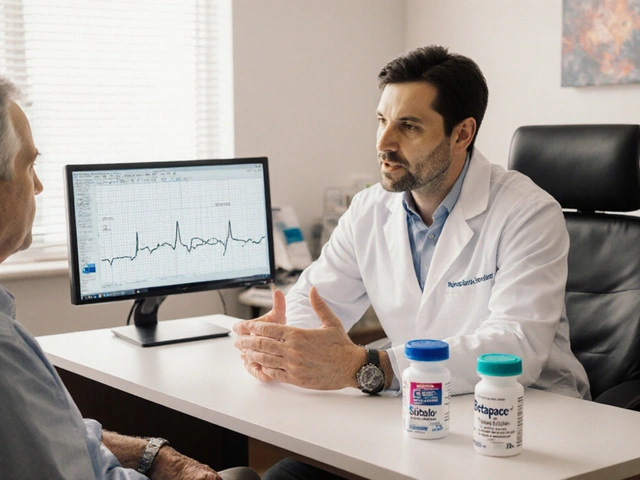Anti-Arrhythmic Drug Selector
Patient Profile
Betapace is a brand name for the anti‑arrhythmic drug sotalol, classified as a ClassIII potassium channel blocker with additional non‑selective β‑adrenergic blocking properties. It sits at the crossroads of rhythm control and rate control, making it a unique option for patients battling both atrial fibrillation and ventricular ectopy.
Mechanistically, sotalol prolongs the cardiac action potential by inhibiting the rapid component of the delayed‑rectifier potassium current (IKr). At the same time, its β‑blockade dampens sympathetic drive, reducing heart‑rate spikes that can trigger arrhythmias. This dual action means clinicians often reach for Betapace when a single‑class drug doesn’t cut it.
Atrial fibrillation and certain ventricular tachyarrhythmias are the primary indications for Betapace. In the United Kingdom, the NICE guidelines list sotalol as a second‑line choice after rate‑control agents have failed to maintain sinus rhythm. Typical maintenance dosing ranges from 80mg twice daily for younger patients to 160mg twice daily for adults weighing over 70kg, with adjustments made for renal function.
Pharmacokinetics matter. Betapace has an oral bioavailability of about 90% and a half‑life of 12‑15hours, allowing twice‑daily dosing. It is excreted unchanged by the kidneys, so a creatinine clearance below 50ml/min mandates dose reduction or avoidance. The drug’s steady‑state concentration is reached after roughly three days, which is why a loading regimen (often 80mg three times daily for the first 48hours) is common in inpatient settings.
Safety is where the conversation gets tricky. Because sotalol blocks IKr, it can lengthen the QT interval and precipitate torsades de pointes, especially in patients with hypokalemia, hypomagnesemia, or concomitant QT‑prolonging drugs. The non‑selective β‑blockade can cause fatigue, bradycardia, and bronchospasm in asthmatics. Routine ECG monitoring after the first dose and then daily for the first week is standard practice.
When doctors consider alternatives, they usually weigh three factors: the underlying rhythm disorder, comorbidities, and the side‑effect profile. Below is a quick snapshot of the most common contenders.
| Drug | Class | Primary Mechanism | Half‑life (hrs) | Typical Dose | Notable Side Effects |
|---|---|---|---|---|---|
| Betapace (Sotalol) | III/II | K⁺ channel block+β‑blockade | 12‑15 | 80‑160mg BID | QT prolongation, bradycardia, bronchospasm |
| Amiodarone | III | Multiple channel block (K⁺, Na⁺, Ca²⁺) &α‑blockade | 30‑55 | 200‑400mg daily (maintenance) | Pulmonary toxicity, thyroid dysfunction, skin photosensitivity |
| Dofetilide | III | Selective IKr block | 10‑13 | 125‑500µg BID (renal‑adjusted) | QT prolongation, renal clearance issues |
| Flecainide | IC | Na⁺ channel block | 12‑15 | 50‑100mg BID | Pro‑arrhythmia in structural heart disease, dizziness |
| Metoprolol | II | Selective β₁‑blockade | 3‑7 | 25‑200mg daily | Bradycardia, fatigue, bronchospasm (high dose) |
| Verapamil | IV | Calcium channel block (L‑type) | 3‑7 | 80‑240mg daily | Constipation, AV block, negative inotropy |
If you’re hunting for the best rhythm‑control pill, Betapace often tops the list for dual action.
Let’s unpack the most common alternatives.
Amiodarone - The “Swiss‑army knife” of anti‑arrhythmics
Amiodarone’s broad‑spectrum channel blockade makes it effective against virtually any tachyarrhythmia, from atrial flutter to ventricular fibrillation. Its long half‑life (up to two months) means patients stay therapeutic after stopping, but it also translates into a higher burden of delayed toxicities. In patients with lung disease or thyroid issues, clinicians tend to avoid amiodarone and look elsewhere.
Dofetilide - A focused IKr inhibitor
Dofetilide delivers pure ClassIII action without β‑blockade, which reduces the risk of bronchospasm. However, its renal clearance mandates tight dosing based on creatinine clearance, and mandatory in‑hospital initiation with continuous ECG monitoring is required because of the torsades risk.
Flecainide - The sodium‑channel specialist
Flecainide shines in patients with “lone” atrial fibrillation and structurally normal hearts. Its rapid onset makes it useful for “pill‑in‑the‑ pocket” strategies, but in the presence of coronary artery disease or left‑ventricular dysfunction, it can become pro‑arrhythmic, so it’s a contraindication in those groups.
Metoprolol - Pure β‑blockade
For patients whose main problem is rate control rather than rhythm conversion, metoprolol offers reliable heart‑rate slowing with a short half‑life that eases dose adjustments. It lacks any direct anti‑arrhythmic effect on the ventricular action potential, so it won’t help maintain sinus rhythm after cardioversion.
Verapamil - Calcium channel option
Verapamil is favored in patients with concomitant hypertension or angina because it also dilates coronary vessels. Its negative inotropic effect means it’s avoided in patients with severe heart failure, and like metoprolol, it provides rate control without modifying the QT interval.

Choosing the right drug - Decision criteria
- Underlying pathology: Structural heart disease or heart failure nudges you away from flecainide and toward amiodarone or sotalol (if QT monitoring is feasible).
- Renal function: Impaired clearance favors amiodarone or metoprolol; dofetilide requires strict dose reduction.
- Comorbid pulmonary disease: Non‑selective β‑blockade in Betapace can provoke bronchospasm; metoprolol’s β₁ selectivity is safer.
- Need for rapid onset: Flecainide or verapamil work quickly, while amiodarone and sotalol need loading periods.
- Monitoring capacity: If you can’t guarantee daily ECGs, a drug with a lower torsades risk (e.g., metoprolol) may be preferable.
Practical monitoring checklist
- Baseline ECG - measure QTc; ensure < 440ms for men, < 460ms for women.
- Serum electrolytes - correct K⁺ >4.0mmol/L, Mg²⁺ >2.0mg/dL.
- Renal function - calculate creatinine clearance before starting sotalol or dofetilide.
- Repeat ECG 2‑4hours after the first dose, then daily for the first week.
- Patient education - warn about symptoms of palpitations, dizziness, or syncope.
Related concepts that often come up
QT prolongation is the unifying safety signal for many ClassIII agents, including sotalol, amiodarone, and dofetilide. Understanding how electrolyte disturbances, drug‑drug interactions (e.g., macrolide antibiotics, fluoroquinolones), and genetic predispositions (Long QT syndrome) influence QTc helps clinicians mitigate risk.
Another frequent crossover is drug interactions. For example, co‑administration of potassium‑sparing diuretics can blunt sotalol‑induced hypokalemia, while CYP2C9 inhibitors (like fluconazole) raise plasma levels of amiodarone.
Next steps for clinicians and patients
If you’re a prescriber, start with a clear assessment of renal function, baseline QTc, and comorbidities. Choose Betapace when you need both rhythm and rate control in a patient without severe lung disease and who can be closely monitored. Switch to an alternative if any of the safety checkboxes fail.
Patients should keep an updated medication list, report any new respiratory symptoms, and attend scheduled ECG appointments. Using a home‑monitoring device that records heart rhythm can provide early warning signs before a clinic visit.
Bottom line
Betapace (sotalol) occupies a niche that blends ClassIII anti‑arrhythmic potency with β‑blockade. It’s a strong contender for patients who need dual action and can be carefully monitored. Alternatives like amiodarone, dofetilide, flecainide, metoprolol, and verapamil each have their own sweet spots, and the right choice hinges on individual risk‑benefit calculus.
Frequently Asked Questions
What is the main difference between Betapace and amiodarone?
Betapace combines a potassium‑channel block with non‑selective β‑blockade, giving both rhythm and rate control, while amiodarone blocks multiple channels (K⁺, Na⁺, Ca²⁺) and has a much longer half‑life, leading to delayed toxicities such as lung and thyroid problems.
Can Betapace be used in patients with asthma?
Because sotalol is a non‑selective β‑blocker, it can trigger bronchospasm in asthmatics. In most cases clinicians prefer a β₁‑selective blocker like metoprolol or avoid β‑blockade altogether.
How often should ECG monitoring be performed after starting sotalol?
A baseline ECG is required, followed by a repeat 2‑4hours after the first dose, then daily for the first week. If the QTc exceeds 500ms, the drug should be stopped immediately.
Is Betapace safe for patients with renal impairment?
Sotalol is cleared unchanged by the kidneys. For creatinine clearance below 50ml/min, the dose should be reduced by 50% or the drug should be avoided altogether to prevent accumulation and QT prolongation.
When is flecainide a better option than Betapace?
Flecainide is preferred in patients with “lone” atrial fibrillation and no structural heart disease, especially when a rapid “pill‑in‑the‑pocket” conversion is desired. It lacks β‑blockade and QT effects, making it safer for those with pulmonary issues.
Can I take Betapace together with other QT‑prolonging drugs?
Co‑prescribing two QT‑prolonging agents dramatically raises the risk of torsades. Combination should be avoided unless absolutely necessary, and if done, intensive ECG monitoring and electrolyte optimization are mandatory.



Kavita Jadhav
September 26, 2025 AT 19:57Hey there, navigating anti‑arrhythmic choices can feel overwhelming, especially when kidney function or lung disease throws extra curves. I always start by double‑checking the QTc and electrolyte panel; a little tweak there can save a lot of headaches later. Sotalol works great for dual rhythm‑rate control, but the daily ECGs are a must‑have safety net. If you have asthma, consider a β₁‑selective blocker like metoprolol instead – it spares the lungs. And never forget to involve the patient in the monitoring plan; they’re more likely to stick with it when they understand the why.
Tony Halstead
September 30, 2025 AT 05:40Building on that, think of the decision matrix as a conversation between the drug’s pharmacology and the patient’s comorbidities. For instance, amiodarone’s long half‑life makes it a fallback when other agents fail, yet you must weigh the pulmonary and thyroid risks. Dofetilide’s renal clearance demands a hospital start, but if the patient can tolerate it, the pure IKr block is elegant. Ultimately, the “best” drug is the one that aligns with the monitoring capacity you have on hand.
leo dwi putra
October 3, 2025 AT 17:00Oh wow, sotalol sounds like the Swiss‑army knife you never asked for.
Krista Evans
October 7, 2025 AT 04:20Totally get the anxiety around QT monitoring – I’ve seen a few patients get freaked out by the extra ECGs. What helped was setting up a simple home‑monitoring device that uploads the strip to the clinic portal; that way you’re not dragging them into the hospital every day. Also, educate them on warning signs like sudden dizziness or palpitations; they’ll call sooner rather than later. And remember, a short loading phase with close observation can catch issues before you commit to long‑term therapy.
Mike Gilmer2
October 10, 2025 AT 15:40Seriously, the drama of “dual‑action” meds is that you’re juggling two side‑effect profiles at once. Sotalol can prolong QT and also knock the lungs on asthmatics – it’s like trying to dance on a tightrope while juggling flaming torches. Amiodarone, on the other hand, is the lazy giant that hangs around for months, but you pay for it with thyroid and lung baggage. If rapid rhythm conversion is the goal, flecainide’s “pill‑in‑the‑pocket” vibe is alluring, provided the heart isn’t scarred. Bottom line: pick the drug whose monitoring you can actually afford to do.
Alexia Rozendo
October 14, 2025 AT 03:00Sure, just slap on sotalol and hope the patient doesn’t turn into a walking ECG alarm. Who needs simplicity when you can have a “monitor‑daily‑or‑die” regimen?
Kimberly Newell
October 17, 2025 AT 14:20Yo, if u got normal kidney fxn and no lung stuff, sotalol can be a good bet. Just keep an eye on that QTc – dont let it go over 500ms or u r asking for trouble. And yeah, daily ECGs are kinda a pain but better than a heart attack later.
Drew Burgy
October 21, 2025 AT 01:40They don’t tell you in the pharma brochures that most of these “safety” studies are funded by the drug companies themselves. It’s no coincidence that sotalol’s monitoring protocol looks like a covert surveillance program. If you’re smart, you’ll sidestep it and choose a drug with a cleaner safety record, like metoprolol, and keep the conspiracies at bay.
Jacob Hamblin
October 24, 2025 AT 13:00From a grammatical standpoint, the article’s table is well‑structured, but a few abbreviations could be expanded for clarity. For example, “BPM” isn’t defined, which might confuse readers unfamiliar with cardiac terminology. Additionally, the checklist could benefit from bullet points rather than a numbered list, since the steps aren’t strictly sequential. Overall, the content is solid, but tightening the language would improve readability.
Andrea Mathias
October 28, 2025 AT 00:20Patriotic doctors should prioritize American‑made anti‑arrhythmics, not imported “foreign” sotalol that comes with hidden monitoring strings. Our own metoprolol offers reliable rate control without the dreaded QT drama. Let’s keep the focus on home‑grown solutions that don’t require daily ECGs and keep our healthcare system strong.
TRICIA TUCKER
October 31, 2025 AT 11:40Okay, squad, let’s break this down in plain English. Sotalol is the only drug here that does both rhythm and rate control, which is a sweet combo if you’re okay with extra paperwork. Amiodarone is the heavyweight champ – it’ll stick around forever, good and bad. Dofetilide is picky about kidney numbers, so you need a doc who actually checks labs. Flecainide is the flash‑in‑the‑pan option for quick fixes, but don’t use it if the heart’s got any scarring. And if you just need to slow the heart down, metoprolol or verapamil are your go‑to, no drama.
Dave Tu
November 3, 2025 AT 23:00While your summary is serviceable, it neglects the nuanced electrophysiological considerations that differentiate class III agents. For instance, the differential IKr blockade potency between sotalol and dofetilide can influence torsades risk stratification. Moreover, verapamil’s impact on AV nodal conduction warrants caution in patients with pre‑existing block. A comprehensive assessment must integrate these subtleties.
Johnna Sutton
November 7, 2025 AT 10:20In accordance with the aforementioned data, it is evident that sotalol’s utilization should be circumscribed to patients devoid of pulmonary compromise. Accordingly, alternative agents may be contemplated.
Vinay Keragodi
November 10, 2025 AT 21:40When I first started prescribing anti‑arrhythmics, I treated each case like a forensic puzzle, gathering clues from labs, imaging, and the patient’s story. The first piece is always the underlying cardiac substrate – structural disease, heart failure, or a truly “lone” atrial fibrillation. If the substrate is scarred, class I agents like flecainide become dangerous because they can turn a stable rhythm into a lethal ventricular tachycardia. That’s why the table correctly warns against flecainide in structural heart disease. Next, I look at renal function; a eGFR under 50 mL/min forces me to either lower the dose of sotalol or abandon it in favor of a drug with hepatic clearance, such as amiodarone. I also check electrolytes – hypokalemia and hypomagnesemia are silent accomplices that magnify QT prolongation risk. In patients with asthma, the non‑selective β‑blockade of sotalol can precipitate bronchospasm, so I switch to a β₁‑selective blocker or a calcium‑channel blocker. The speed of onset is another practical concern; for rapid conversion I reach for flecainide or verapamil, but I accept a slower loading phase with sotalol if the patient can wait. Monitoring capacity is the final, often overlooked, factor: daily ECGs are doable in a hospital or well‑equipped clinic, but not in a rural setting without telemetry. If I cannot guarantee that monitoring, I opt for a drug with a more forgiving safety profile, such as metoprolol. The pharmacokinetics also matter – sotalol’s half‑life of 12‑15 hours means twice‑daily dosing, which some patients find inconvenient, whereas amiodarone’s long half‑life can be a blessing for compliance but a curse for delayed toxicity. I also counsel patients about the need to avoid QT‑prolonging antibiotics or antipsychotics while on a class III agent. Drug‑drug interactions can be subtle; for example, fluconazole can raise amiodarone levels, while potassium‑sparing diuretics may mitigate sotalol‑induced hypokalemia. Ultimately, the decision matrix is a balance of efficacy, safety, patient lifestyle, and healthcare resources. By systematically evaluating each criterion, I can personalize therapy and reduce the chance of adverse events. This methodical approach has saved me from many late‑night calls and, more importantly, from putting patients at unnecessary risk.